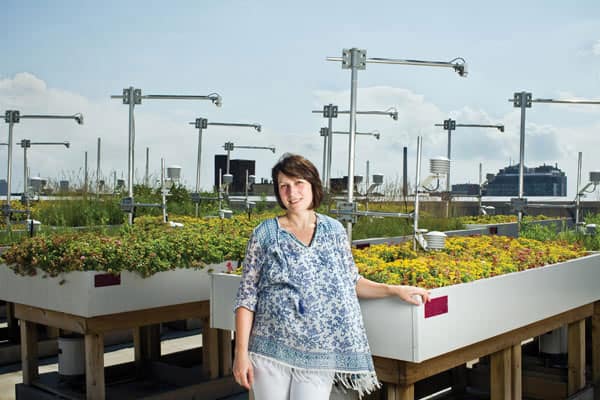As the Director of U of T’s Green Roof Innovation Testing Laboratory (GRIT Lab), Liat Margolis is passionate about how art and architecture can merge to support our natural environment. We chatted with her about what she does, and how her research is poised to change our future for the better.
SDTC: What do you do at the GRIT Lab?
LM: At the Green Roof Innovation Testing Laboratory (GRIT Lab), we evaluate the environmental performance of green-building technologies that are becoming an increasingly common component of design and construction standards in cities. Such technologies include green (vegetated) roofs, green (vining) façades, and green roof integrated solar photovoltaics. For instance, the City of Toronto adopted a Green Roof Bylaw that requires all new construction above 2,000 square metres to install an extensive green roof. In this context, our research team studies different green roof configurations to capture rainfall and decrease runoff and subsequent urban flooding.
We also study the potential of green roofs to lower the surface temperature of the roof, which has local and regional implications on urban heat and energy consumption. Finally, we study how material choices and maintenance practices influence plant growth and biodiversity, and how that in turn impacts water management, cooling, and pollinator habitat.
In terms of the green facades, we look at how vining plants that grow on trellises against a building wall can cool the surface of the wall through shading and evapotranspiration and lead to energy conservation.
Lastly, we are investigating whether combining green roofs and solar would optimize energy production, while also providing with the hydrological and ecological co-benefits.
What about this technology would surprise people?
Regardless of the material choices (i.e., growing media and plant types) and maintenance practices (e.g., irrigation), an extensive (10-15cm) green roof system captures 85-90% of the volume of water during the peak of a storm. This means green roofs can play a critical role in alleviating the pressure on our aging and inadequate water infrastructure, thus reducing flooding and the damage and loss that ensues.
What are the advantages/disadvantages of green roofs?
The advantage is that they are multi-functional; they capture water, cool the air, provide insulation for the building rooftop, increase species habitat, improve air quality, and provide with a beautiful social space. That said, in our research, we have found that performance is subject to design, where some material and maintenance choices work better than others for different categories of environmental and aesthetic performance.
The disadvantage is that they do add loading (weight) to the building rooftop and structure. This may not be an issue for new construction, if considered as part of the original design intent, but it may be a limiting factor for retrofitting existing buildings.
The other limiting factor is cost; however, the City of Toronto offers a financial incentive for green roof construction. When property owners are made aware of the cost benefits of green roofs and other landscape-based technologies, they may approach the initial investment with a long-term lens of the cost savings.
Are there any practical steps we can take to green our own space (even if we’re not major building developers)?
Absolutely. The City of Toronto established the Eco-Incentive program, which provides people with financial subsidies to retrofit existing structures as small as a one-car garage, or even smaller.
Or, if they’re looking for an easier version, they can retrofit it with a “green façade.” They attach it to the building envelope with brackets. The vining plants will then cover the trellis, act as a rain screen for the façade, cool the building surface, and make the building façade more beautiful.
What do you want people to know about green roofs?
First, since the City of Toronto 2009 Green Roof Bylaw, over one million square feet of green roofing has been installed (or is in the process of being installed).
Second, in addition to water management and cooling, green roofs are important for pollinators, including bees. Massive urbanization in Toronto and other cities has resulted in the paving over of our natural, ecological areas and has negatively impacted biodiversity and overall number of species. We depend on bees and other insects for pollinating our urban plants, fruit trees, etc.
Green roofs compensate for that loss by providing the necessary foraging and nesting habitat to a surface that would otherwise be a barren roof amidst a concrete jungle. That said, the devil’s in the details; growing media and plant choices, irrigation and building height all matter for the successful creation of a biodiverse pollinator habitat, and this is where evidence-based research comes in.
Liat Margolis will be speaking as part of Future Environments: Art and Architecture in Action on Wednesday, May 3, 2017 at the University of Toronto’s Convocation Hall (31 King’s College Circle). Doors open at 4:30 p.m.; the event starts at 5:30 p.m., followed by a reception from 7 p.m. to 9 p.m. at the Art Museum. Tickets are free and guests must register online here.



 Follow Us On Instagram
Follow Us On Instagram
